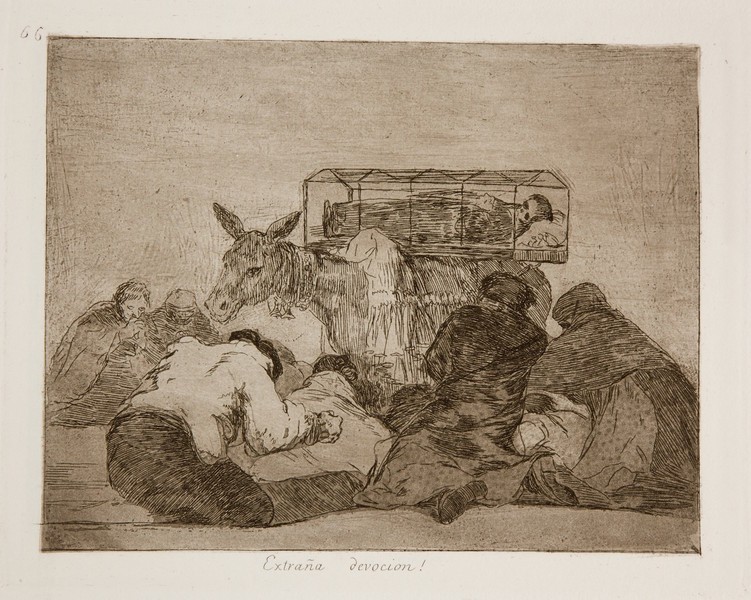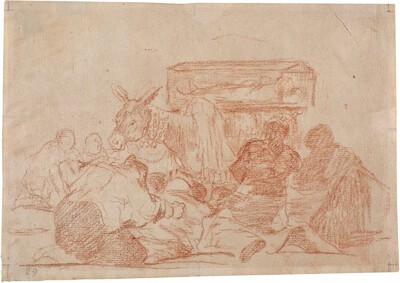- Cronología
- Ca. 1820 - 1823
- Dimensiones
- 177 x 222 mm
- Técnica y soporte
- Aguafuerte, aguatinta bruñida y/o lavis y bruñidor
- Reconocimiento de la autoría de Goya
- Undisputed work
- Ficha: realización/revisión
- 22 Dec 2010 / 24 May 2023
- Inventario
- 225
See Sad forebodings of what is to come.
The title of the print was handwritten by Goya on the first and only series known to us at the time of its production, which the painter gave to his friend Agustín Ceán Bermúdez. Thus the title was subsequently engraved on the plate without any modification from Ceán Bermúdez's copy for the first edition of LDisasters of War published by the Royal Academy of Fine Arts of San Fernando in Madrid in 1863.
A preparatory drawing is kept in the Prado Museum.
In the centre of the engraving, a donkey carries on its back an urn in which the mummified body of a saint can be seen, possibly, as Jesusa Vega points out, the Blessed Mariana de Jesús, to whom the people of Madrid had an important devotion. As she passes by, the faithful prostrate themselves, bowing their heads and acknowledging the importance of the image.
As Nigel Glendinning has pointed out, it is likely that Goya was inspired by the fables of Félix María Samaniego (Laguardia, Álava, 1745-1801) and José Agustín Ibáñez de la Rentería (Bilbao, 1751-Lequeitio, 1826). In this way, the donkey to which all this respect is being paid for being the bearer of something sacred is, in reality, an animal usually associated with ignorance, which corresponds to the first part of the fable by Samaniego and Ibáñez de Rentería. This is not the first time that the donkey has been associated with ignorance in Goya's artistic production, as it appears, among other cases, in Witches' Flight and in the prints of Los Caprichos known as "asnerías".
Roberto Alcalá, for his part, points to the validity of Glendinning's theory although he believes that Goya may have drawn on other sources of inspiration such as the emblems of Andrea Alciato (Alzano, Milan, 1493-Pavía, 1550), perhaps the one entitled Non tibi, sed religione in which the following was said in the Spanish translation according to Pinciano's version: "No a vos sino a la religión/ Como un asnillo que a la Ceres Santa/ Con tardo paso en procesión llevaba/ Viese por toda parte gente tanta/ Que a cada paso en par de él se humillaba/ En tal soberbia entre sí se levanta/ Que a si se dio el honor que a ella se daba/ Hasta que el palo y voz dieron junto:/ No sois vos Dios mas llevais su trasunto". Furthermore, Alcalá believes that Goya may also have seen emblem VI, entitled Ficta religio.
To understand the true meaning of this image, we must turn to the next print in the series, no. 67, Which is no less important. The painter has drawn an analogy between the donkey carrying the relics in the first print and the figures, possibly noblemen, carrying an image of the Virgin on their shoulders in the next print. The link between the two prints is indicated by their titles, although there is also a formal relationship, as Goya repeats the compositional structure of print 66 in no. 67.
As Glendinning points out, the Aragonese painter is clearly criticising the superstition of the people, who give certain characters of little importance an aura that does not correspond to reality. However, this idea could coexist at the same time with an open censure of the political regime in force, since Ferdinand VII had re-established the principles of the Ancien Régime and, with it, certain privileges, including those enjoyed by the Church. He had also encouraged many of the customs that the war had annulled, such as the processions. These, as popular manifestations of the faith, had been criticised even by members of the Church itself, such as Father Benito Jerónimo Feijóo (Casdemiro, Pereiro de Aguiar, 1676-Oviedo, 1764) and the Jesuit Father José Francisco de Isla (Vidanes, León, 1703-Bologna, 1781). However, the regime of Ferdinand VII gave them a new relevance that Goya criticises unequivocally in these two engravings.
The plate is in the National Chalcography (cat. 317).
-
Goya y el espíritu de la IlustraciónMuseo Nacional del PradoMadrid1988from October 6th to December 18th 1988. Exhibited also at Museum of Fine Arts, Boston, January 18th to March 26th 1989; The Metropolitan Museum of Art, Nueva York, May 9th to July 16th 1989, Madrid curator Manuela B. Mena Marqués, scientific directors Alfonso E. Pérez Sánchez and Eleanor A. Sayrecat. 154
-
Francisco Goya. Sein leben im spiegel der graphik. Fuendetodos 1746-1828 Bordeaux. 1746-1996Galerie KornfeldBern1996from November 21st 1996 to January 1997cat. 156
-
Francisco Goya. Capricci, follie e disastri della guerraSan Donato Milanese2000Opere grafiche della Fondazione Antonio Mazzottacat. 146
-
Goya et la modernitéPinacothèque de ParisParís2013from October 11st 2013 to March 16th 2014cat. 105
-
Agen2019cat. 63
-
Goya, grabadorBibliography']['numberMadridBlass S.A.1918cat. 168
-
El asno cargado de reliquias en Los desastres de la guerra de GoyaArchivo español de arteBibliography']['number1962p.224
-
Goya engravings and lithographs, vol. I y II.Bibliography']['numberOxfordBruno Cassirer1964cat. 186
-
Vie et ouvre de Francisco de GoyaBibliography']['numberParísOffice du livre1970cat. 1106
-
A solution to the enigma of Goya’s emphatic caprices nº 65-80 of The Disasters of WarApolloBibliography']['number1978pp.186-191
-
Fuentes emblemáticas del asno cargado de reliquias de la serie Los desastres de la guerra de Goya1982GoyaBibliography']['number1982pp.274-278
-
Goya y el espíritu de la IlustraciónBibliography']['numberMadridMuseo del Prado1988pp.424-434, cat. 154
-
Catálogo de las estampas de Goya en la Biblioteca NacionalBibliography']['numberMadridMinisterio de Educación y Cultura, Biblioteca Nacional1996cat. 281
-
Francisco de Goya. Los Desastres de la guerraBibliography']['numberBarcelonaLa Central2011p.43
-
Bibliography']['number
ParísPinacoteca de París2013p. 152
-
Goya. In the Norton Simon MuseumBibliography']['numberPasadenaNorton Simon Museum2016pp. 114-151
-
Bibliography']['number
AgenSnoeck2019p. 115

